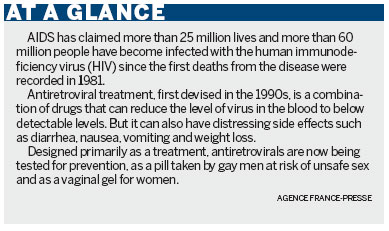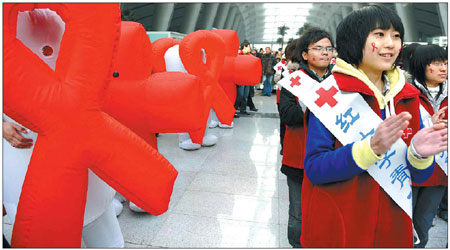Health
'Game-changer' in fight against AIDS
Updated: 2011-05-18 08:24
(China Daily)
|
Young volunteers gather in Beijing South Railway Station at an event held by Chinese Red Cross to increase awareness of AIDS. Zhou Min / for China Daily |
A new study on heterosexual couples appears to show that individuals with HIV who take antiretroviral drugs significantly reduce the likelihood of infecting their partners.
People with HIV who take antiretroviral drugs before their health declines have a 96 percent lower risk of transmitting the virus to a partner, according to a breakthrough global study.
The large study that covered mainly heterosexual couples in Africa, India and the Americas was hailed by AIDS experts as a "game-changer" that will transform how the disease is managed, 30 years after it first surfaced.
Until now, antiretroviral therapy was known to improve the health of people infected with human immunodeficiency virus, but this is the first study to show a solid impact on preventing transmission to an HIV-negative partner.
"This is excellent news," says Myron Cohen, lead investigator on the study and director of the Institute of Global Health and Infectious Diseases at the University of North Carolina, at Chapel Hill.
"This is the first randomized clinical trial to definitively indicate that an HIV-infected individual can reduce sexual transmission of HIV to an uninfected partner by beginning antiretroviral therapy sooner."
The trial began in 2005 and included 1,763 couples - 97 percent of whom were heterosexual - and was carried out at 13 sites in countries including Brazil, Thailand, Zimbabwe, India and South Africa.
The HIV-infected partners included 890 men and 873 women.
The randomization phase was halted early once researchers realized that the drug regimen was having such a significant blocking effect on the risk of spreading the infection.
Some couples were placed into a delayed group, in which the infected partner began taking antiretroviral therapy (ART) only when a type of T-cell known as CD4 dipped below 250 cells per millimeter cubed, or if he or she developed an AIDS-related illness.
The other group began taking ART immediately. In that group, just one case of HIV transmission was observed.
There were 27 HIV transmissions in the delayed group that could be traced directly to the infected partner, a difference the study described as "highly statistically significant".
National Institute of Allergy and Infectious Diseases chief Anthony Fauci hailed the findings.
"Previous data about the potential value of antiretrovirals in making HIV-infected individuals less infectious to their sexual partners came largely from observational and epidemiological studies," Fauci says.
"This new finding convincingly demonstrates that treating the infected individual - and doing so sooner rather than later - can have a major impact on reducing HIV transmission."
According to Wafaa el-Sadr, a member of the executive committee of the HIV Prevention Trials Network (HPTN), the group that did this study, the results should have a major impact on treatment guidelines.
"I think HPTN 052 will always be recognized as a landmark study that truly may transform treatment as well as prevention of HIV globally," she says.
Sadr, who is also a professor of medicine and epidemiology at Columbia University in New York, says the couples in the study would continue to be followed.
The study was initially set to continue until 2015 but the independent safety and monitoring board halted the randomization phase early "because of the very clear and remarkable benefits that were shown", she says.
"They determined that these findings were so profoundly important that they had to be shared immediately," she says.
Executive director of the Joint United Nations Program on HIV/AIDS (UNAIDS), Michel Sidibe, describes the study as "a game-changer" that "will drive the prevention revolution forward".
Agence France-Presse

E-paper

Green works
Wuxi becomes 'test case' for facing country's environmental challenges
Preview of the coming issue
The global rise of Chinese brands
China-EU trade on solid ground
Specials

The song dynasty
There are MORE THAN 300 types of Chinese operas but two POPULAR varieties are major standouts

Cut above the rest
One of the world's oldest surgeons has performed more than 14,000 operations

From the ground up
Architect of Guangzhou Opera House has many projects under way, including 2012 Olympics.

